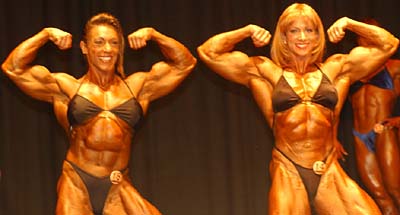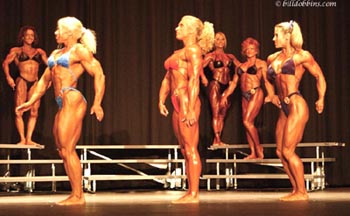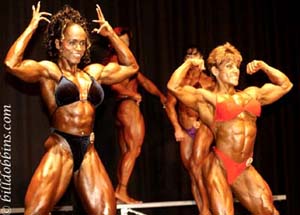KEEPING SCORE:
A LOOK AT THE IFBB JUDGING SYSTEM
Why there is no such thing as
a symmetry,
muscularity or posing round.
By Bill Dobbins
INTRODUCTION
Bodybuilding contests over the years have been judged using a number of
different procedures. In the early days of “"Physical Culture"
contests, competitors were required to demonstrate their athletic ability
on stage---a precursor of today’s fitness contests for women.
Many early bodybuilding contests also involved evaluating the personalities
and public speaking abilities of the contestants, who would talk briefly
on stage in addition to showing off their physiques.
 Bodybuilders
have been divided into categories based on age and experience (novice, teenage
and masters, for example) as well as by height or by weight. Scoring
has been done using a rigid points system in an effort to emulate various
established Olympic sports and, more informally, with the judges going off
in private, discussing the contest among themselves, and coming to a conclusion
much like a jury in a court trial.
Bodybuilders
have been divided into categories based on age and experience (novice, teenage
and masters, for example) as well as by height or by weight. Scoring
has been done using a rigid points system in an effort to emulate various
established Olympic sports and, more informally, with the judges going off
in private, discussing the contest among themselves, and coming to a conclusion
much like a jury in a court trial.
The point of any and all of these judging systems and procedures, is (or at least should be) to identify the best bodybuilders and rank them according to excellence. That is, the goal of judging is not to define what good bodybuilding is supposed to be but to recognize it.
Ultimately, it is the bodybuilders themselves who define what is possible in physique competition. Judges would not expect to see, or to demand to see, for example, cross-striations in the glutes unless or until they had already seen such a level of development on stage. As in other sports such as gymnastics and diving, a competitor comes along and establishes a new standard---maybe one previously thought to be impossible---and then suddenly everyone else starts working to duplicate that feat. As an example, look how long it took for runners to break the four-minute mile barrier. But once one runner did it, suddenly hundreds were accomplishing the same thing.
Fundamentally, judging in bodybuilding is based on the ability of the judges to know what a good bodybuilder looks like when they see one. If a judge doesn’t have a good "eye" for bodybuilding, it doesn’t really matter what kind of system of rules is used. So the effectiveness of judging rules and procedures should be evaluated basically using one criteria---does the system help the judges in identifying the best bodybuilders, or does it make it difficult or even impossible for them to do so?
THE NPC JUDGING SYSTEM
The National Physique Committee, which governs amateur bodybuilding
in the United States, uses a comparatively simple system of judging.
All the judging for individual classes takes place during the prejudging
(recently, the federation has begun doing some of the judging during the
finals, but most still takes place during afternoon prejudging). Selecting
an overall champion from among the class winners takes place during the
finals. When an NPC competitor poses in the finals to music, this
is strictly a show for the audience. The scoring has already been
completed.
In an NPC contest, each bodybuilder in a class comes out individually and does a one-minute free-posing routine, with no music. The entire line-up is then brought out on stage together and the judges bring out groups of competitors---starting with what seems to be the top five or so---for comparison posing. There are no “mandatory” poses as such, but the bodybuilders are generally asked to do most of the common, conventional physique poses---front double-biceps, lat spread, side-chest and so forth. However, the judges can call for any pose they want---a most-muscular, for example, or simply for “your best leg shot.”
NPC judges don’t score the rounds separately, but simply rank each bodybuilder in order once prejudging for the class is over. So when an NPC judge finally places a competitor, that score doesn’t reflect any single aspect of the bodybuilder’s physique or presentation but a complete, overall evaluation of his or her excellence.
THE IFBB JUDGING SYSTEM
The IFBB, which sanctions international amateur and professional bodybuilding
competition, has a more complex and structured set of judging procedures.
The prejuding consists of two rounds. In the first, the bodybuilders
assume a "standing relaxed" posture (something like standing at
attention, arms at the sides) and are looked at from the front, back and
both sides. In the second, the competitors go through a very specific
set of mandatory poses. In both rounds, the bodybuilders are looked
at individually and are compared as well, although unlike the NPC system
- where the judges can call out any number of competitors in a group - usually
only three competitors are brought out for comparison at a time.
Another difference between the NPC and the IFBB procedures is that IFBB judges score each round separately, placing the bodybuilders in order of excellence for that individual round, and a competitor’s score represents his or her cumulative scores from all of the rounds.
IFBB scoring is not completed once prejuding is over. The competitors don't do their free posing during prejudging, but are evaluated by the judges as they perform their routines to music in the finals. Once the third round is completed and the scores are added up, the top finalists are then brought out for an additional "pose-down" round and have an opportunity to make a final impression on the judges.
ALL ROUNDS ARE PHYSIQUE ROUNDS
The IFBB system of judging has been largely effective, with comparatively
few controversial decisions resulting (except for the intrusion of the politically-inspired
"guidelines" recently applied to female bodybuilding) when you
consider how difficult it is to achieve an “objective” consensus
of something with so subjective a nature as bodybuilding judging.
But when problems have arisen, it is often because there is a tendency on
the part of some judges, when working within such a highly structured system,
to forget that bodybuilding is a physique contest and that every round in a bodybuilding contest is supposed
to be a physique round.
That is, the judges are supposed to look at every aspect of the competitors in every round and to judge each round as if that were the entire contest. Judges should say to themselves, “If this were all I was going to get to see of these bodybuilders, if this were the whole contest, who would I place first, second, third and so forth?”
ROUND ONE
But this often doesn’t happen. For example, the “standing
relaxed” round is often called the "symmetry round."
This is  because,
when the bodybuilders are not flexing and posing, and they can’t cover
up physique faults by how they hit their poses, the aspects of their physiques
that stand out tend to be their overall shape, symmetry and proportion.
But the first round is not a symmetry round
- that is, it is not a round in which the judges are looking at symmetry
as if it were a separate and distinct element of the bodybuilding physique.
It is a physique round in which every feature of the body
that can be observed should be considered. For example, a judge should
not give a high placing to a competitor with an aesthetic shape and good
proportions, but who lacks mass or density, is not hard and defined or who
is lacking in any other aspect of physical development or conditioning.
because,
when the bodybuilders are not flexing and posing, and they can’t cover
up physique faults by how they hit their poses, the aspects of their physiques
that stand out tend to be their overall shape, symmetry and proportion.
But the first round is not a symmetry round
- that is, it is not a round in which the judges are looking at symmetry
as if it were a separate and distinct element of the bodybuilding physique.
It is a physique round in which every feature of the body
that can be observed should be considered. For example, a judge should
not give a high placing to a competitor with an aesthetic shape and good
proportions, but who lacks mass or density, is not hard and defined or who
is lacking in any other aspect of physical development or conditioning.
As with the other rounds, the judges should score the competitors as if this were the entire contest, decided on the basis of what they can see while the competitors are "standing relaxed" who the best bodybuilders on stage are in order of excellence.
click for text on "standing relaxed pose
ROUND TWO
The same is true of the second round. The bodybuilders do mandatory
poses, flex their muscles, and this tends to show off their muscularity,
but it is not a “muscularity” round. Of
course, when competitors start to pose a physique that seemed relatively
unimpressive in round one can seem to come alive, muscles popping out all
over. But while this should certainly count in her or his favor, it
doesn’t mean a bodybuilder’s other obvious faults or weaknesses
should be ignored. Again, the judges are supposed to look at the competitors
in this round and ask themselves, “Who would I place first, second
and so forth if this round were the entire contest and this was all I was
going to see?”
The point of the different rounds is give the judges as much information as possible on the physiques they are evaluating. You see different things when a competitor is just standing there or when he or she flexes and poses. Someone who doesn’t impress you in one round might well change your mind in another. But the bodybuilding physique must always be looked at as a whole and be judged and evaluated in its entirety in each and every round.
ROUND THREE
When it comes to round three, presentation is a vitally important aspect
of a physique contest, but it is not a “posing” round.
The idea of posing is a simple one: the competitor has had to show the judges
his or her physique the way they wanted to see it; in round three, the bodybuilders
have a chance to show-off their development in a way that maximizes their
strong points and minimizes their weaknesses.
and minimizes their weaknesses.
But the physique being presented in round three is the same one the judges have seen in the previous two rounds---and they pretty much know what it looks like by now. So bodybuilders shouldn’t expect to jump a whole lot of places in the scoring because they are able to do an exciting routine. They might, however, in calling attention to certain of their strengths, cause a judge to think, “You know, that bodybuilder is really better than I gave him (or her) credit for.” Its an unfortunate fact of genetics that many physiques don’t look all that good in certain poses---although they might be very impressive in others. And that’s what round three is all about---showing the judges your physique in a way that is the most flattering to you and impressive as possible.
IN CONCLUSION
The IFBB judging system obviously works, and the judges
who officiate in IFBB contests have proven track records. But there
has been a tendency on the part of judges, bodybuilders and spectators alike
to think of round one as a “symmetry” round, round two as a
“muscularity” round and the third round as a “posing round,”
and therefore to look at isolated aspects of the physique (or non-physique
aspects such as posing) rather than the physique as a whole.
This approach to judging can skew the results in such a way that, in spite
of the best intentions of the judges, some of the competitors might not
receive the placings they really deserve.
The remedy for this situation is for the judges to keep in mind at all times that they should base their evaluations on everything they see in every round, to judge each round as if it were the entire contest, and to keep in mind that bodybuilding is a physique contest and therefore every round in a bodybuilding competition is a physique round.